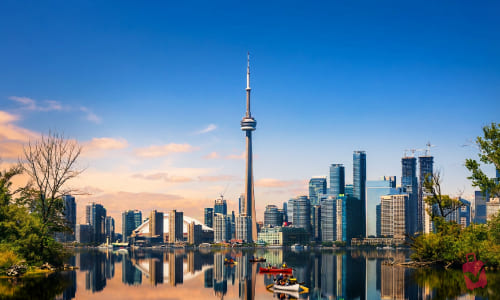Toronto welcomes visitors in every season. But winter brings a friendlier mix of families, students and travellers who enjoy warm indoor places and walking routes to enjoy the season.
The city feels even busier this year because World Cup trips are pulling new visitors into Canada. I visited Toronto in winter many times and every trip showed me a new detail about staying comfortable and enjoying the city.
So, in this guide I’m bringing together everything you need for exploring historical landmarks in Toronto with a clear winter plan. This will work perfectly for combined World Cup travel or just your casual Toronto visits as well!
Table of Content
- Toronto’s Oldest and Most Iconic Historical Landmarks
- Where to Explore Toronto’s Oldest Architecture
- Budget Friendly Historical Landmarks in Toronto
- Learning About Indigenous and Early Settler History in Toronto
- Historical Landmarks in Toronto Outside the Busy Areas
- Practical Tips for Visiting Historical Landmarks in Toronto
- Historical Spots Near BMO Field for Combined Visits
- Final Thoughts on Exploring Historical Landmarks in Toronto
- FAQs
- More Related Blogs From Travel Recommendations
Toronto’s Oldest and Most Iconic Historical Landmarks
Old City Hall

Old City Hall opened in 1899 and still operates as a courthouse. The exterior uses sandstone and detailed carvings that reflect late nineteenth century design. Winter mornings specifically feel refreshing here because the open plaza allows a wide view of the surrounding streets. This place works well as a starting point for exploring Toronto heritage buildings during any winter visit.
Nathan Phillips Square

Nathan Phillips Square stays active in winter due to its large outdoor skating rink. The square sits beside Old City Hall and gives a clear view of the glowing Toronto sign. Seasonal events, concerts and small stalls fill the space during the holidays.
Casa Loma
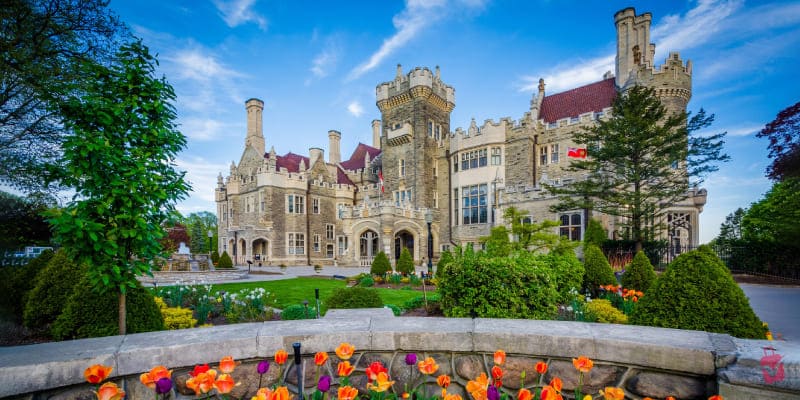
Casa Loma sits on a hill with the look of a European-style estate. The warm lighting inside always feels inviting, and it has become one of our favourite historic places to revisit in Toronto. Whenever I go with my partner, we end up in the tower section because the view stays interesting in every season, even when the city is covered in soft snow.
Fort York National Historic Site

Fort York remains an essential place for anyone learning about Toronto history. The site includes original structures from the War of 1812 and explains how the early town grew around this military post. The audio guides explain everything in a way that even first time visitors can follow easily. Personally, I feel like this is one of the strongest historical landmarks in Toronto for learning.
Where to Explore Toronto’s Oldest Architecture
Toronto holds clusters of preserved buildings from different eras. These areas stay enjoyable for walks because the paths feel clear and the surroundings remain active throughout the day.
Distillery Historic District
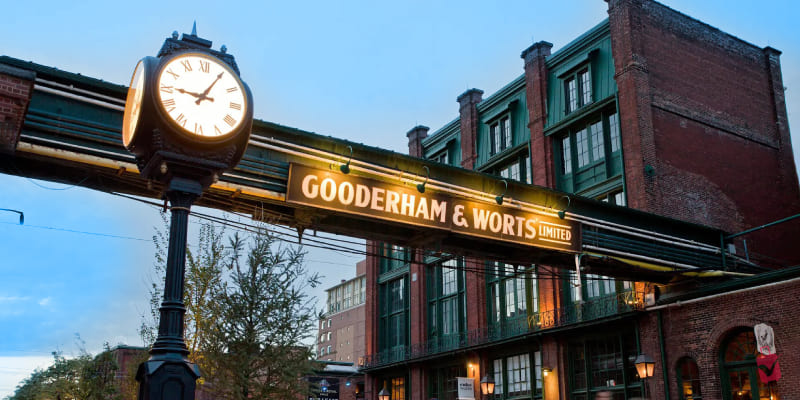
The Distillery District in Toronto started as a major whiskey production site in the 19th century. The preserved red brick buildings, stone lanes and warm winter lights make the area pleasant for slow winter walks.
Gooderham Building

The Gooderham Building dates back to 1892. Its narrow pointed shape makes it one of the most recognisable old buildings in Toronto. The modern towers behind it create a striking contrast that visitors love photographing.
University of Toronto St George Campus
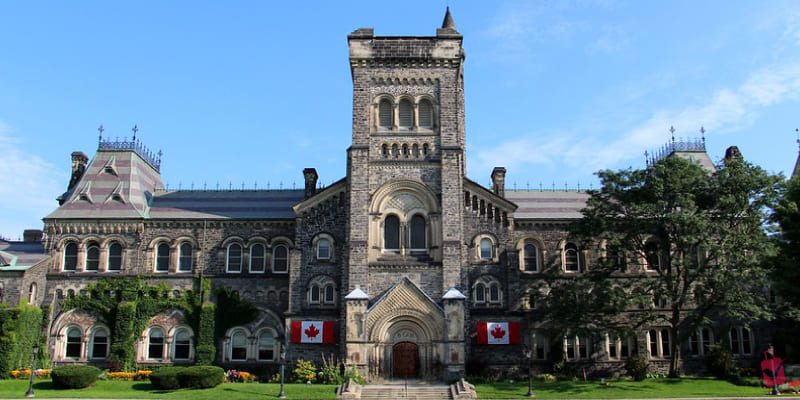
The St George campus carries some of the oldest academic structures in Canada. University College opened in the mid 19th century and displays a blend of Gothic and Romanesque design.
Historic Churches and Government Sites in Toronto

The streets near Queen’s Park hold several important heritage spots. St James Cathedral includes high ceilings, stained glass and woodwork from the nineteenth century. The Ontario Legislative Building sits nearby with rounded arches and strong stonework.
Budget Friendly Historical Landmarks in Toronto
Winter trips can sometimes feel expensive, yet Toronto has many historical places you can enjoy without worrying about cost. The city museums that offer free general admission are a good starting point. Fort York, Spadina Museum, Gibson House Museum, Mackenzie House, Colborne Lodge and Montgomery’s Inn all sit close to transit. This allows you to move around with flexibility. And on top of that, it’s free!
I still haven’t visited every single one yet, but my friends often talk about how welcoming the staff are and how each place tells a small part of the city’s past. Outdoor areas like the Distillery District, the Gooderham Building, Old City Hall, the St Lawrence Market area and the University of Toronto campus also create easy winter walks with plenty to look at even on colder days.
Families with kids can visit St James Cathedral or other churches during open hours. This really gives a calm moment indoors and a closer look at older architectural styles that shaped Toronto’s story.
Learning About Indigenous and Early Settler History in Toronto
Learning about indigenous culture and early settler life in Toronto adds more depth to the trip. The city keeps museums, community centres and outdoor sites that reflect thousands of years of history. If you’re visiting with kids, it’s an easy and enjoyable way to spark their curiosity about history and help them learn without feeling like they’re in a classroom.
Native Canadian Centre of Toronto

The Native Canadian Centre offers community programs that include storytelling, basic language introductions and cultural workshops. These sessions help visitors understand traditions that shaped the region long before the modern city existed.
Fort York and Early Toronto

Fort York helps visitors understand interactions between Indigenous groups and early settlers during the War of 1812. The site is suitable for beginners who want to learn about early Toronto history in a friendly way.
Spadina Museum and Black Creek Pioneer Village

Spadina Museum displays early 20th century life through preserved rooms, furniture and clothing. Black Creek Pioneer Village presents 19th century life through period homes, workshops and outdoor paths. Both places offer an easy way to learn about different stages of Toronto’s growth.
Victoria Memorial Square
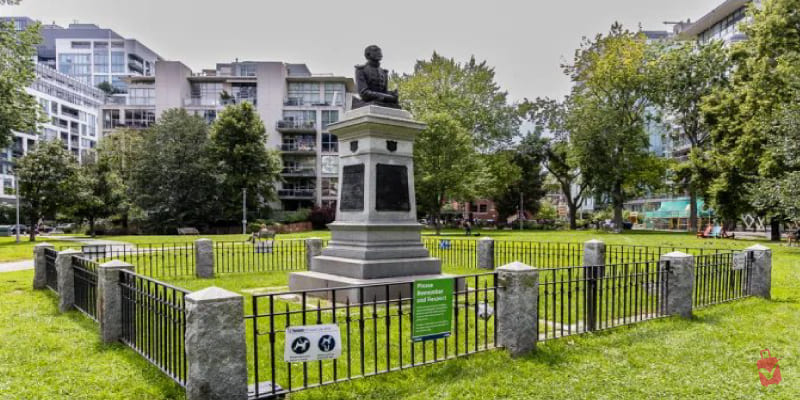
Historical Landmarks in Toronto Outside the Busy Areas
Some of the most peaceful historical landmarks in Toronto sit just outside the busy centre and are easy to reach even in winter.After a day of crowds and bright lights, these quieter heritage sites in Toronto offer a slower chance to breathe. They also feel unexpectedly emotional.
You can’t help but feel a little heavy hearted standing in rooms where lives were once lived so differently. Montgomery’s Inn brings that warmth to life. The preserved rooms and kitchen setting make you imagine travellers sharing food and stories. Todmorden Mills, beside the Don River, blends open grounds with heritage buildings and short trails.
If you take walks there, you’ll start noticing small details in Toronto’s history and instantly feel connected to its natural side. On the other hand, the Gibson House Museum is quietly moving for families and history fans. The guided tours explain everyday life in 19th century North York and make history feel personal.
Osgoode Hall and St Lawrence Hall showcase Victorian architecture and grand historic buildings in Toronto. Their gates and landscaped grounds make you slow down and listen to the city’s community history. Together these places create a reflective, human way to explore Toronto’s past.
Practical Tips for Visiting Historical Landmarks in Toronto
From my own experience, these quick tips will help travellers enjoy historical landmarks in Toronto both during winter and World Cup travel.
- Check opening times because winter reduces daylight
- Use transit for simple movement between sites
- Wear comfortable shoes, older pavements can feel uneven
- Keep gloves and an extra layer ready if temperature changes
- Join guided programs when possible
Historical Spots Near BMO Field for Combined Visits
If you’re planning a World Cup trip, it’s a great idea to balance the hectic energy of match days with slower, reflective visits to Toronto’s history.BMO Field is part of Exhibition Place, a site full of stories from the city’s past. Just steps away, the Princes’ Gates welcome visitors with their grand neoclassical design. Taking a moment here can feel surprisingly calming after a stadium roar.
Nearby, the Scadding Cabin, built in 1794, gives a real glimpse into early settler life in Toronto. Walking around it, I always imagine the small daily routines that shaped the city long before the stadium existed. Another interesting stop is the Fort Rouillé monument, where the outline of a French trading post reminds you how much history has extended in the area.
Architecture enthusiasts will enjoy the Horticulture Building, with its elegant Beaux-Arts style, along with other historic Exhibition Place buildings like the old Fire Hall and Police Station. Even the granite benches around the grounds celebrate Toronto’s heritage in a subtle, thoughtful way. Combining these historic visits with match-day excitement makes your trip feel rich, varied, and memorable.
Final Thoughts on Exploring Historical Landmarks in Toronto
Toronto offers a mix of preserved buildings, winter friendly museums and easy walking routes. The combination of indoor learning, outdoor paths and warm community spaces helps visitors move comfortably through the city even in colder months. Every time I return, I notice a new detail on one of the older streets or learn something small from a guide at Fort York.
If you follow even a few ideas from this guide, your winter trip through historical landmarks in Toronto will feel warm, informative and memorable. It also sets the perfect pace for travellers heading toward Vancouver for World Cup events!
FAQs
Top picks include Old City Hall, Casa Loma, Fort York, the Distillery District, St. Lawrence Market, and the Gooderham Building. These sites give you a clear sense of Toronto’s architectural and cultural history.
Yes. Toronto’s 10 city-run history museums offer free general admission, and heritage areas like the Distillery District, Gooderham Building and University of Toronto campus are open to explore at no cost.
A strong route is Old City Hall to St. Lawrence Market, then the Gooderham Building and the Distillery District, with Fort York added by transit.
Casa Loma, Fort York, the Distillery District and Old City Hall work well in winter thanks to their mix of indoor exhibits and short outdoor paths.
The Gooderham Building, Casa Loma, Old City Hall and the Distillery District are strong winter photography spots because their brickwork and architecture look great in colder light.
More Related Blogs From Travel Recommendations
Festivals and Events in Boston That Actually Fit Your Budget
Globally Hyped Festivals and Events in Atlanta
Festivals and Events in Toronto 2025-2026: Guide for World Cup Visitors
Margaret C. Jones
Margaret C. Jones, a passionate explorer of North America, captivates readers with her vivid tales on Travelarii’s blog. With a keen eye for hidden gems and local culture, Margaret offers expert advice and unique insights to enhance your travel experience. Her stories bring the diverse landscapes and vibrant cities of North America to life, inspiring readers to embark on their own adventures.
